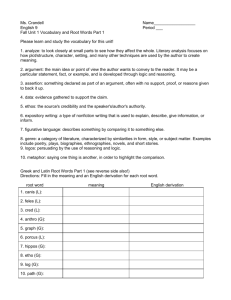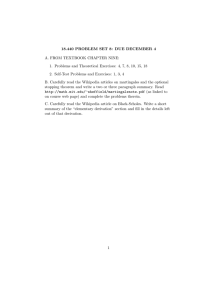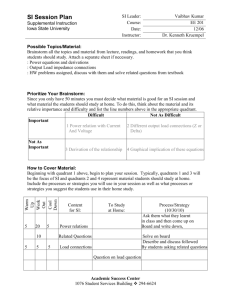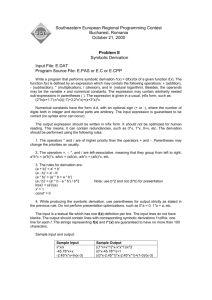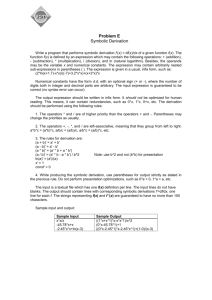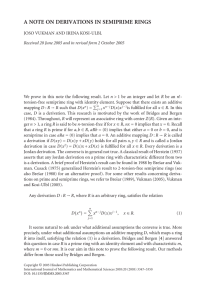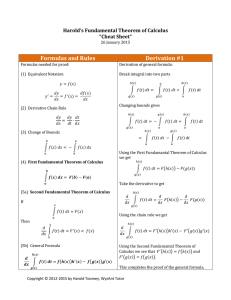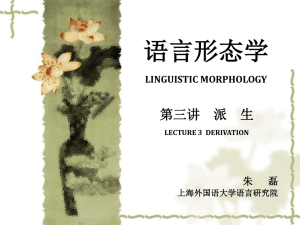Hindawi Publishing Corporation Journal of Inequalities and Applications
advertisement
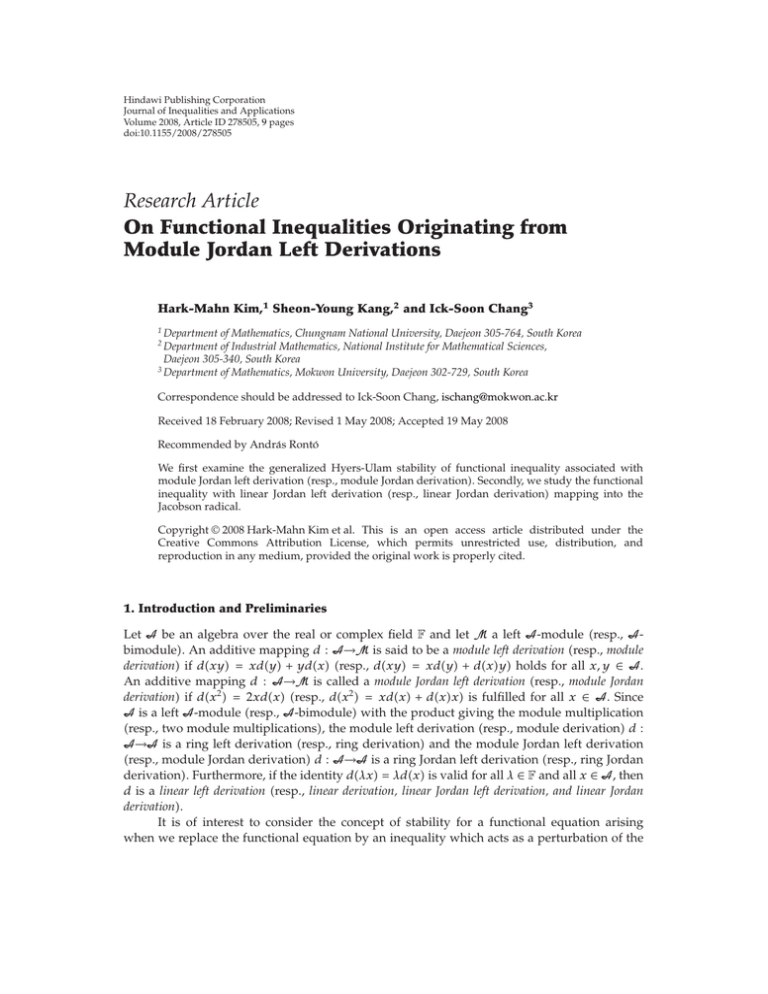
Hindawi Publishing Corporation
Journal of Inequalities and Applications
Volume 2008, Article ID 278505, 9 pages
doi:10.1155/2008/278505
Research Article
On Functional Inequalities Originating from
Module Jordan Left Derivations
Hark-Mahn Kim,1 Sheon-Young Kang,2 and Ick-Soon Chang3
1
Department of Mathematics, Chungnam National University, Daejeon 305-764, South Korea
Department of Industrial Mathematics, National Institute for Mathematical Sciences,
Daejeon 305-340, South Korea
3
Department of Mathematics, Mokwon University, Daejeon 302-729, South Korea
2
Correspondence should be addressed to Ick-Soon Chang, ischang@mokwon.ac.kr
Received 18 February 2008; Revised 1 May 2008; Accepted 19 May 2008
Recommended by András Rontó
We first examine the generalized Hyers-Ulam stability of functional inequality associated with
module Jordan left derivation resp., module Jordan derivation. Secondly, we study the functional
inequality with linear Jordan left derivation resp., linear Jordan derivation mapping into the
Jacobson radical.
Copyright q 2008 Hark-Mahn Kim et al. This is an open access article distributed under the
Creative Commons Attribution License, which permits unrestricted use, distribution, and
reproduction in any medium, provided the original work is properly cited.
1. Introduction and Preliminaries
Let A be an algebra over the real or complex field F and let M a left A-module resp., Abimodule. An additive mapping d : A→M is said to be a module left derivation resp., module
derivation if dxy xdy ydx resp., dxy xdy dxy holds for all x, y ∈ A.
An additive mapping d : A→M is called a module Jordan left derivation resp., module Jordan
derivation if dx2 2xdx resp., dx2 xdx dxx is fulfilled for all x ∈ A. Since
A is a left A-module resp., A-bimodule with the product giving the module multiplication
resp., two module multiplications, the module left derivation resp., module derivation d :
A→A is a ring left derivation resp., ring derivation and the module Jordan left derivation
resp., module Jordan derivation d : A→A is a ring Jordan left derivation resp., ring Jordan
derivation. Furthermore, if the identity dλx λdx is valid for all λ ∈ F and all x ∈ A, then
d is a linear left derivation resp., linear derivation, linear Jordan left derivation, and linear Jordan
derivation.
It is of interest to consider the concept of stability for a functional equation arising
when we replace the functional equation by an inequality which acts as a perturbation of the
2
Journal of Inequalities and Applications
equation. The study of stability problems had been formulated by Ulam 1 during a talk in
1940: Under what condition does there exist a homomorphism near an approximate homomorphism?
In the following year, Hyers 2 was answered affirmatively the question of Ulam for Banach
spaces, which states that if ε > 0 and f : X→Y is a map with X a normed space, Y a Banach space
such that
||fx y − fx − fy|| ≤ ε
1.1
for all x, y ∈ X, then there exists a unique additive map T : X→Y such that
||fx − T x|| ≤ ε
1.2
for all x ∈ X. A generalized version of the theorem of Hyers for approximately additive
mappings was given by Aoki 3 in 1950 cf. also 4 and for approximately linear mappings
it was presented by Rassias 5 in 1978 by considering the case when inequality 1.1 is
unbounded. Due to that fact, the additive functional equation fx y fx fy is said to
have the generalized Hyers-Ulam stability property. The stability result concerning derivations
between operator algebras was first obtained by Šemrl 6. Recently, Badora 7 gave a
generalization of the Bourgin’s result 8. He also dealt with the Hyers-Ulam stability and
the Bourgin-type superstability of ring derivations in 9.
In 1955, Singer and Wermer 10 obtained a fundamental result which started
investigation into the ranges of linear derivations on Banach algebras. The result, which
is called the Singer-Wermer theorem, states that every continuous linear derivation on a
commutative Banach algebra maps into the Jacobson radical. They also made a very insightful
conjecture, namely, that the assumption of continuity is unnecessary. This was known as
the Singer-Wermer conjecture and was proved in 1988 by Thomas 11. The Singer-Wermer
conjecture implies that every or equivalently, linear left derivation linear derivation on a
commutative semisimple Banach algebra is identically zero which is the result of Johnson
12. After then, Hatori and Wada 13 showed that a zero operator is the only ring derivation
on a commutative semisimple Banach algebra with the maximal ideal space without isolated
points. Note that this differs from the above result of Johnson. Based on these facts and a
private communication with Watanabe 14, Miura et al. proved the the generalized HyersUlam stability and Bourgin-type superstability of ring derivations on Banach algebras in 14.
On the other hand, Gilányi 15 and Rätz 16 proved that if f is a mapping such that the
functional inequality
2fx 2fy − fx − y ≤ fx y,
1.3
then f satisfies the Jordan-von Neumann functional equation
2fx 2fy fx y fx − y.
1.4
Moreover, Fechner 17 and Gilányi 18 showed the generalized Hyers-Ulam stability of the
functional inequality 1.3.
The main purpose of the present paper is to offer the generalized Hyers-Ulam stability
of functional inequality associated with module Jordan left derivation resp., module Jordan
left derivation. In addition, we investigate the functional inequality with linear Jordan left
derivation resp., linear Jordan derivation mapping into the Jacobson radical.
Hark-Mahn Kim et al.
3
2. Functional inequalities for module Jordan left derivations
Throughout this paper, we assume that k is a fixed positive integer.
Theorem 2.1. Let A be a normed algebra and let M be Banach left A-module. Suppose that f : A→M
is a mapping such that
1
2 fu fv fw − 2xfx ≤ fku kv kw − kx k
2.1
for all u, v, w, x ∈ A. Then f is a module Jordan left derivation.
Proof. Setting x 0 in 2.1 and using the Park’s result 19, we see that f is additive. Letting
u v 0 and w x2 in 2.1 gives
1
0
f0
fx2 − 2xfx ≤ k
2.2
for all x ∈ A, which implies that fx2 2xfx for all x ∈ A. So we conclude that f is a
module Jordan left derivation. This completes the proof of the theorem.
We now establish the generalized Hyers-Ulam stability of functional inequality
associated with module Jordan left derivation.
Theorem 2.2. Let A be a normed algebra and let M be a Banach left A-module. Suppose that f :
A→M is a mapping for which there exists a function Φ : A 4 →0, ∞ such that
v
w
x
< ∞,
,
,
,
2j1 2j1 2j1 2j1
j0
1
2 fu fv fw − 2xfx ≤ fku
kv
kw
−
kx
k
Φu, v, w, x
∞
4j Φ
u
2.3
for all u, v, w, x ∈ A. Then there exists a unique module Jordan left derivation d : A→M satisfying
fx − dx ≤
∞ j0
2j Φ
−x −x x
x −x
j1
,
,
,
0
2
Φ
,
,
0,
0
2j1 2j1 2j
2j1 2j1
2.4
for all x ∈ A.
Proof. Letting u v w x 0 in 2.3, we get
3k − 1
f0 ≤ Φ0, 0, 0, 0.
k
2.5
Since limn→∞ 4n Φ0, 0, 0, 0 0, we have Φ0, 0, 0, 0 0. Hence f0 0. Let us take u v x, w −2x and x 0 in 2.3. Then we obtain
2fx f−2x ≤ Φx, x, −2x, 0
2.6
4
Journal of Inequalities and Applications
for all x ∈ A. Replacing x by −x/2 in the previous part, we get
fx 2f −x ≤ Φ −x , −x , x, 0
2 2 2
2.7
for all x ∈ A. Letting u x, v −x and w x 0 in 2.3, we arrive at
fx f−x ≤ Φx, −x, 0, 0
2.8
for all x ∈ A. Therefore by 2.7 and 2.8, we have
m−1
l
j
2 f x − 2m f x ≤
2 f x − 2j1 f x m
j
j1
l
2
2
2
2
jl
≤
2j f x 2j1 f −x 2j1 f −x 2j1 f x j
j1
j1
j1
2
2
2
2
m−1
jl
≤
m−1
2j Φ
jl
−x −x x
x −x
j1
,
,
,
0
2
Φ
,
,
0,
0
2j1 2j1 2j
2j1 2j1
2.9
for all integers l, m with m > l ≥ 0 and all x ∈ A. It follows that for each x ∈ A the sequence
{2n fx/2n } is Cauchy and so it is convergent, since M is complete. Let d : A→M be a mapping
defined by x ∈ A,
dx : lim 2n f
n→∞
x
.
2n
2.10
By letting l 0 and passing m→∞, we get inequality 2.4.
First of all, we note from 2.8 that
x
−x x −x
n
dx d−x ≤ lim 2 f n f
≤ lim 2 Φ n , n , 0, 0 0
n→∞
2
2n n→∞
2 2
n
2.11
for all x ∈ A. So we have d−x −dx for all x ∈ A. Letting u x, v y, w −x − y and
x 0 in 2.3, we find that
fx fy f−x − y ≤ Φx, y, −x − y, 0
2.12
for all x, y ∈ A. We obtain by 2.12 that
dx dy − dx y dx dy d−x − y
y
−x − y x
n
lim 2 f n f n f
n→∞
2
2
2n
x y −x − y
≤ lim 2n Φ n , n ,
,0 0
n→∞
2 2
2n
2.13
Hark-Mahn Kim et al.
5
for all x, y ∈ A, that is, d is additive. Setting u v 0 and w x2 in 2.3 yields
fx2 − 2xfx ≤ Φ0, 0, x2 , x
2.14
for all x ∈ A. Using inequality 2.14, we get
2
n
x
x x2 x
n
n
≤
lim
0
dx − 2xdx lim 4 f n − 2x · 2 f n 4
Φ
0,
0,
,
n→∞
4
2 n→∞
4n 2n
2
2.15
for all x ∈ A, which means that dx2 2xdx for all x ∈ A. Therefore, we conclude that d is
a module Jordan left derivation.
Suppose that there exists another module Jordan left derivation D : A→M satisfying
inequality 2.4. Since Dx 2n Dx/2n and dx 2n dx/2n , we see that
x x
−
d
Dx − dx 2n D
n
2
2n x
x
x x n ≤ 2 D n − f n f n − d n 2.16
2
2
2
2 ∞ −x −x x
x −x
2j Φ j1 , j1 , j , 0 2j1 Φ j1 , j1 , 0, 0 ,
≤2
2
2
2
2
2
jn
which tends to zero as n→∞ for all x ∈ A. So that D d as claimed and the proof of the
theorem is complete.
Theorem 2.3. Let A be a normed algebra and let M be a Banach left A-module. Suppose that f :
A→M is a mapping for which there exists a function Φ : A 4 →0, ∞ such that
∞
1
Φ2j u, 2j v, 2j w, 2j x < ∞
j
2
j0
2.17
and inequality 2.3 for all u, v, w, x ∈ A. Then there exists a unique module Jordan left derivation
d : A→M satisfying
∞
1
k2
j
j1
j
j1
j1
fx − dx ≤
Φ2 x, 2 x, −2 x, 0 Φ2 x, −2 x, 0, 0 Φ0, 0, 0, 0
j1
3k − 1
j0 2
2.18
for all x ∈ A.
Proof. By the same reasoning as in the proof of Theorem 2.2, we find that
1
1
f0 ≤
Φ0, 0, 0, 0.
k
3k − 1
2.19
If we take u v x, w −2x and x 0 in 2.3, then we get
2fx f−2x ≤ Φx, x, −2x, 0 1
Φ0, 0, 0, 0
3k − 1
2.20
6
Journal of Inequalities and Applications
for all x ∈ A. It follows that
fx f−2x
1
1
≤
Φx, x, −2x, 0 Φ0, 0, 0, 0
2
2
3k − 1
2.21
for all x ∈ A. Letting u x, v −x and w x 0 in 2.3, we arrive at
fx f−x ≤ Φx, −x, 0, 0 k1
Φ0, 0, 0, 0
3k − 1
2.22
for all x ∈ A. Making use of 2.21 and 2.22, we have
f2l x f2m x m−1
f2j x f2j1 x 2l − 2m ≤
2j − 2j1 jl
≤
jl
≤
j
j1
j1
j1
f2 x f−2 x f−2 x f2 x 2j
j1
j1
j1
2
2
2
m−1
m−1
jl
k2
j
j1
j
j1
j1
Φ0,
0,
0,
0
Φ2
x,
2
x,
−2
x,
0Φ2
x,
−2
x,
0,
0
3k−1
2j1
1
2.23
for all integers l, m with m > l ≥ 0 and all x ∈ A. So the sequence {f2n x/2n } is Cauchy. Since
M is complete, the sequence {f2n x/2n } converges. Let d : A→M be a mapping defined by
x ∈ A
f2n x
.
n→∞
2n
dx : lim
2.24
By letting l 0 and sending m→∞ in 2.9, we obtain the inequality 2.18.
The remaining part of the proof can be carried out similarly as in that of the previous
theorem.
Remark 2.4. Let f be a mapping from a normed algebra A into a Banach A-bimodule M. As in
the previous theorems, we can prove that if f satisfies the functional inequality
1
2 fu fv fw − xfx − fxx ≤ fku
kv
kw
−
kx
k
,
2.25
then f is a module Jordan derivation and under suitable condition of Φ, we can obtain the
generalized Hyers-Ulam stability of the functional inequality
1
2 fku
kv
kw
−
kx
fu fv fw − xfx − fxx ≤ Φu, v, w, x.
k
2.26
Hark-Mahn Kim et al.
7
3. Jacobson radical ranges of Jordan left derivations
Every ring left derivation resp., ring derivation on ring is a Jordan left derivation resp., ring
Jordan derivation. The converse is in general not true. It was shown by Ashraf and Rehman
20 that a ring Jordan left derivation on a 2-torsion free prime ring is a left derivation. In
particular, a famous result due to Herstein 21 states that a ring Jordan derivation on a 2torsion free semiprime ring is a derivation. In view of Thomas’ result 11, derivations on
Banach algebras now belong to the noncommutative setting. Among various noncommutative
versions of the Singer-Wermer theorem, Brešar and Vukman 22 proved the followings: every
ring left derivation on a semiprime ring is derivation which maps into its center and also every
continuous linear left derivation on a Banach algebra maps into its Jacobson radical.
The followings are the functional inequality with problems as in Brešar and Vukman’s
result.
Theorem 3.1. Let A be a prime Banach algebra. Suppose that f : A→A is a mapping such that
1
2 αfu fv fw − 2xfx ≤ 3.1
fkαu
kv
kw
−
kx
k
for all u, v, w, x ∈ A and all α ∈ U {z ∈ C : |z| 1}. Then f is a linear left derivation which maps
A into the intersection of its center ZA and its Jacobson radical radA.
Proof. Let α 1 ∈ U in 3.1. By Theorem 2.1, f is a ring Jordan left derivation.
Setting v −αu and w x 0 in 3.1, we get αfu fαu for all u ∈ A and all
α ∈ U. Clearly, f0x 0 0fx for all x ∈ A. Let us assume that λ is a nonzero complex
number and that L a positive integer greater than |λ|. Then by applying a geometric argument,
there exist λ1 , λ2 ∈ U such that 2λ/L λ1 λ2 . In particular, by the additivity of f, we obtain
fx/2 1/2fx for all x ∈ A. Thus we have that
L
λ
1
λ
fλx f
· 2 · x Lf
·2· x
2
L
2
L
L
fλ1 λ2 x 2
L
λ1 λ2 fx 2
L
fλ1 x fλ2 x
2
L
λ
· 2 · fx λfx
2
L
3.2
for all x ∈ A, so that f is C-linear. Therefore f is a linear Jordan left derivation. Since A is
prime, f is a linear left derivation.
Note that prime Banach algebras are semiprime according to Brešar and Vukman’s result
which tell us that f is a linear derivation which maps A into its center ZA. Since ZA is a
commutative Banach algebra, the Singer-Wermer conjecture tells us that f|ZA maps ZA into
radZA ZA ∩ radA and thus f 2 A ⊆ radA. Using the semiprimeness of radA as
well as the identity,
2fxyfx f 2 xyx − xf 2 yx − f 2 xyx xf 2 yx
3.3
for all x, y ∈ A, we have fA ⊆ radA, that is, f is a linear derivation which maps A into the
intersection of its center ZA and its Jacobson radical radA and so the proof of the theorem
is ended.
8
Journal of Inequalities and Applications
Corollary 3.2. Let A be a prime Banach algebra. Suppose that f : A→A is a continuous mapping
satisfying inequality 3.1. Then f maps A into its Jacobson radical radA.
Proof. On account of Theorem 3.1, we see that f is a linear left derivation on A. Since f is
continuous, f maps A into its Jacobson radical radA by Brešar and Vukman’s result. This
completes the proof of the theorem.
With the help of the Thomas’ result 11, we obtain the following.
Theorem 3.3. Let A be a commutative semiprime Banach algebra. Suppose that f : A→A is a
mapping such that
1
2 αfu fv fw − xfx − fxx ≤ fkαu kv kw − kx k
3.4
for all u, v, w, x ∈ A and all α ∈ U {z ∈ C : |z| 1}. Then f maps A into its Jacobson radical
radA.
Proof. Employing the same argument in the proof of Theorem 3.1, we find that f is a linear
Jordan derivation. Since A is semiprime, f is a linear derivation. Thomas’ result guarantees
that f maps A into its Jacobson radical radA, which completes the proof of the theorem.
Recall that semisimple Banach algebras are semiprime 23. Based on that fact, the
following property can be derived.
Corollary 3.4. Let A be a commutative semisimple Banach algebra. Suppose that f : A→A is a
mapping satisfying inequality 3.4. Then f is identically zero.
Acknowledgments
This study was financially supported by research fund of Chungnam National University
in 2007. The authors would like to thank referees for their valuable comments regarding a
previous version of this paper. The corresponding author dedicates this paper to his late father.
References
1 S. M. Ulam, Problems in Modern Mathematics, chapter 6, John Wiley & Sons, New York, NY, USA, 1964.
2 D. H. Hyers, “On the stability of the linear functional equation,” Proceedings of the National Academy of
Sciences of the United States of America, vol. 27, no. 4, pp. 222–224, 1941.
3 T. Aoki, “On the stability of the linear transformation in Banach spaces,” Journal of the Mathematical
Society of Japan, vol. 2, pp. 64–66, 1950.
4 D. G. Bourgin, “Classes of transformations and bordering transformations,” Bulletin of the American
Mathematical Society, vol. 57, pp. 223–237, 1951.
5 Th. M. Rassias, “On the stability of the linear mapping in Banach spaces,” Proceedings of the American
Mathematical Society, vol. 72, no. 2, pp. 297–300, 1978.
6 P. Šemrl, “The functional equation of multiplicative derivation is superstable on standard operator
algebras,” Integral Equations and Operator Theory, vol. 18, no. 1, pp. 118–122, 1994.
7 R. Badora, “On approximate ring homomorphisms,” Journal of Mathematical Analysis and Applications,
vol. 276, no. 2, pp. 589–597, 2002.
8 D. G. Bourgin, “Approximately isometric and multiplicative transformations on continuous function
rings,” Duke Mathematical Journal, vol. 16, pp. 385–397, 1949.
Hark-Mahn Kim et al.
9
9 R. Badora, “On approximate derivations,” Mathematical Inequalities & Applications, vol. 9, no. 1, pp.
167–173, 2006.
10 I. M. Singer and J. Wermer, “Derivations on commutative normed algebras,” Mathematische Annalen,
vol. 129, no. 1, pp. 260–264, 1955.
11 M. P. Thomas, “The image of a derivation is contained in the radical,” Annals of Mathematics, vol. 128,
no. 3, pp. 435–460, 1988.
12 B. E. Johnson, “Continuity of derivations on commutative algebras,” American Journal of Mathematics,
vol. 91, pp. 1–10, 1969.
13 O. Hatori and J. Wada, “Ring derivations on semi-simple commutative Banach algebras,” Tokyo Journal
of Mathematics, vol. 15, no. 1, pp. 223–229, 1992.
14 T. Miura, G. Hirasawa, and S.-E. Takahasi, “A perturbation of ring derivations on Banach algebras,”
Journal of Mathematical Analysis and Applications, vol. 319, no. 2, pp. 522–530, 2006.
15 A. Gilányi, “Eine zur Parallelogrammgleichung äquivalente Ungleichung,” Aequationes Mathematicae,
vol. 62, no. 3, pp. 303–309, 2001.
16 J. Rätz, “On inequalities associated with the Jordan-von Neumann functional equation,” Aequationes
Mathematicae, vol. 66, no. 1-2, pp. 191–200, 2003.
17 W. Fechner, “Stability of a functional inequality associated with the Jordan-von Neumann functional
equation,” Aequationes Mathematicae, vol. 71, no. 1-2, pp. 149–161, 2006.
18 A. Gilányi, “On a problem by K. Nikodem,” Mathematical Inequalities & Applications, vol. 5, no. 4, pp.
707–710, 2002.
19 C. Park and Th. M. Rassias, “Homomorphisms and derivations in proper JCQ∗ -triples,” Journal of
Mathematical Analysis and Applications, vol. 337, no. 2, pp. 1404–1414, 2008.
20 M. Ashraf and N.-U. Rehman, “On Lie ideals and Jordan left derivations of prime rings,” Archivum
Mathematicum, vol. 36, no. 3, pp. 201–206, 2000.
21 I. N. Herstein, “Jordan derivations of prime rings,” Proceedings of the American Mathematical Society,
vol. 8, no. 6, pp. 1104–1110, 1957.
22 M. Brešar and J. Vukman, “On left derivations and related mappings,” Proceedings of the American
Mathematical Society, vol. 110, no. 1, pp. 7–16, 1990.
23 F. F. Bonsall and J. Duncan, Complete Normed Algebras, vol. 80 of Ergebnisse der Mathematik und ihrer
Grenzgebiete, Springer, New York, NY, USA, 1973.
